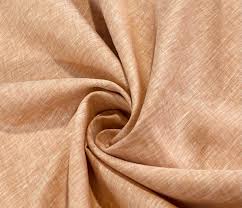The Future of Crepe Fabric in Interior Design

nterior design is constantly evolving, with trends coming and going as quickly as the seasons change. However, one fabric that has remained a staple in the world of fashion is now making its way into the realm of home decor—crepe. Known for its elegant drape, smooth texture, and versatile nature, crepe has long been a favorite in clothing and accessories. Now, designers and homeowners alike are discovering the beauty and functionality of this unique material in interior design. As we look to the future of crepe in interiors, it’s clear that its potential is only just beginning to be realized.
What Makes Crepe Fabric So Special?
Crepe is typically made from silk, wool, or synthetic fibers and is characterized by its crinkled, textured surface. This texture is achieved through a special weaving technique, giving it a slight stretch and a fluid drape. This quality makes it ideal for fashion, as it molds beautifully to the body, creating flattering silhouettes. However, it’s not just the feel of crepe that makes it perfect for home interiors—its aesthetic appeal also plays a significant role.
Crepe offers a subtle sheen that adds sophistication and depth to any space. The fabric’s texture and fluidity provide a sense of movement and elegance, enhancing the overall ambiance of a room. Whether used for upholstery, curtains, or decorative accents, crepe’s ability to reflect light and create visual interest is unmatched.
Crepe Fabric in Upholstery
One of the most exciting uses of this material in interior design is in upholstery. Designers are beginning to experiment with it for furniture pieces, from armchairs to sofas. The rich texture of crepe provides a distinctive look that can elevate any room, while its durability ensures it can withstand the wear and tear of daily life. The fabric is soft to the touch, yet strong enough for high-traffic areas, making it an excellent choice for both contemporary and traditional interior designs.
Using crepe for upholstery allows designers to create a refined, timeless look without sacrificing comfort. Its unique texture can add depth to a neutral-colored sofa or armchair, creating a focal point in the room. Additionally, the versatility of crepe means it can be easily paired with other materials, such as leather or wood, for a balanced, chic aesthetic.
Crepe Fabric in Curtains and Draperies
Another area where crepe is gaining popularity is in curtains and draperies. The luxurious drape of the material allows curtains to fall gracefully and evenly, creating a sense of flow in the space. Whether you’re looking for heavy, floor-to-ceiling drapes or lightweight, airy curtains, crepe provides the perfect balance of structure and softness.
Its subtle sheen also adds a touch of glamour to any room. Crepe fabric reflects light in a way that enhances the natural lighting in the space, making rooms feel brighter and more inviting. Whether used in living rooms, bedrooms, or even dining areas, crepe curtains can bring sophisticated, understated elegance to your home.
The Role of Crepe in Sustainable Interior Design
As sustainability continues to be a major focus in the design world, eco-friendly fabrics are becoming increasingly important. Crepe, particularly those made from natural fibers such as silk or organic cotton, fits seamlessly into the movement toward sustainable interior design. These fabrics are biodegradable and often require less water and chemicals to produce than other synthetic materials, making them a more eco-conscious choice for the environmentally aware homeowner.
Using sustainable fabrics in interior design not only helps to reduce environmental impact but also promotes a sense of timeless elegance that transcends fleeting trends. With its durability and long-lasting beauty, crepe is a fabric that can withstand years of use while maintaining its appeal.
Innovative Uses of Crepe Fabric in Home Decor
As we look to the future of this material in interior design, it’s clear that designers are constantly finding new and innovative ways to incorporate it into home decor. One emerging trend is the use of crepe for wall hangings and fabric art. The texture and movement of crepe can create stunning visual pieces that add interest and dimension to otherwise bare walls. Whether in bold, abstract patterns or soft, flowing designs, crepe fabric wall art brings a unique, tactile element to any space.
Additionally, crepe can be used for smaller decor items such as throw pillows, bedding, or lampshades. The softness and fluidity of the fabric allow it to create luxurious, inviting accents that complement a wide range of interior styles. Whether paired with more traditional furnishings or used as part of a modern, minimalist design, crepe can be an essential part of creating a well-rounded, sophisticated home.
Looking Ahead: The Future of Crepe Fabric in Interior Design
As we move forward, it’s likely that we will see more widespread use of crepe in all aspects of interior design. With its inherent beauty, versatility, and sustainable qualities, crepe is well-positioned to become a key player in the design trends of the future. From furniture upholstery to drapery and decorative accents, this fabric offers designers the opportunity to create spaces that are both luxurious and functional.
Incorporating crepe into your home can add a timeless touch of elegance while also embracing the growing demand for eco-conscious choices in interior design. Whether you’re redecorating a living room or outfitting an entire home, crepe is a beautiful, sustainable option that can help transform any space.
Conclusion
The future of crepe fabric in interior design looks incredibly promising. As designers continue to explore new ways to use this versatile material, it will likely become an even more integral part of modern home decor. From upholstery and curtains to sustainable design solutions, crepe’s rich texture, elegance, and eco-friendly appeal make it a standout choice for creating stylish and sustainable interiors.






